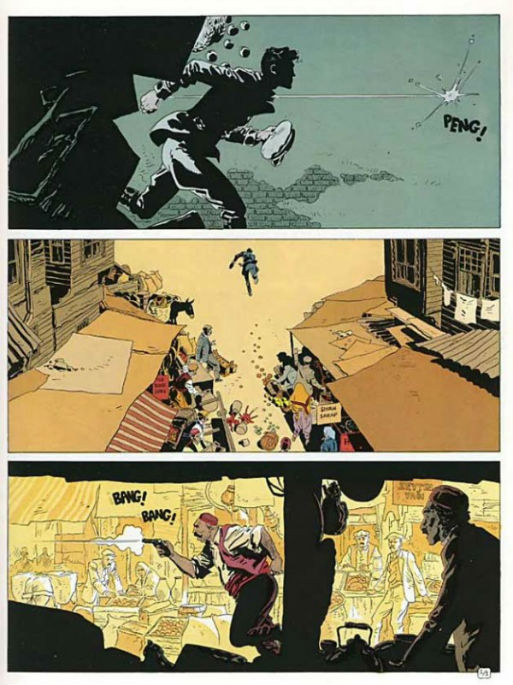
As the Scriptures remind us, “Do not believe the hype.” The hype of the moment is ISIS, the Sunni militia that just drove the so-called Iraqi Army out of Mosul, Tikrit, and other Iraqi cities.
This is one of those dramatic military reverses that mean a lot less than meets the eye. The “Iraqi Army” routed by ISIS wasn’t really a national army, and ISIS isn’t really a dominant military force. It was able to occupy those cities because they were vacuums, abandoned by a weak, sectarian force. Moving into vacuums like this is what ISIS is good at. And that’s the only thing ISIS is good at.
ISIS is a sectarian Sunni militia—that’s all. A big one, as militias go, with something like 10,000 fighters. Most of them are Iraqi, a few are Syrian, and a few hundred are those famous “European jihadis” who draw press attention out of all relation to their negligible combat value. The real strength of ISIS comes from its Chechen fighters, up to a thousand of them. A thousand Chechens is a serious force, and a terrifying one if they’re bearing down on your neighborhood. Chechens are the scariest fighters, pound-for-pound, in the world.
But we’re still talking about a conventional military force smaller than a division. That’s a real but very limited amount of combat power. What this means is that, no matter how many scare headlines you read, ISIS will never take Baghdad, let alone Shia cities to the south like Karbala. It won’t be able to dent the Kurds’ territory to the north, either. All it can do—all it has been doing, by moving into Sunni cities like Mosul and Tikrit—is to complete the partition of Iraq begun by our dear ex-president Bush in 2003. By crushing Saddam’s Sunni-led Iraq, the Americans made partition inevitable. In fact, Iraq has been partitioned ever since the invasion; it’s just been partitioned badly, into two parts instead of the natural three: the Kurdish north, and the remainder occupied by a weak sectarian Shia force going by the name of “The Iraqi Army.” The center of the country, the so-called “Sunni Triangle,” had no share in this partition and was under the inept, weak rule of the Shia army.
By occupying the Sunni cities, ISIS has simply made a more rational partition, adding a third part, putting the Sunni Triangle back under Sunni rule. The Shia troops who fled as soon as they heard that the ISIS was on the way seem to have anticipated that the Sunni would claim their own territory someday. That’s why they fled without giving even a pretense of battle.
So, Iraq is now partitioned on more natural, sensible lines, thanks to ISIS. It’s going to be a messy transition, as Iraqi transitions tend to be, with mass executions of collaborators like those already happening in Mosul and Tikrit.
But in the long run, ISIS has simply swept into a power vacuum, like it’s done from the start.
ISIS has always been good at generating scary stories about itself, like the notion that it was kicked out of Al Qaeda for being “too extreme.” It’s true that ISIS has a beef with Zawahiri, the nominal head of Al Qaeda, but the issue isn’t extremism. Their quarrel was a turf war about who would get the Al Qaeda franchise in Syria, and it just showed ISIS’s most pronounced characteristic in action: A real knack for moving in on vulnerable turf.
In fact, ISIS’s quarrel with Zawahiri was a lot like a corporate boardroom feud. It’s always worth remembering that Jihadis are just friggin’ people, and their disagreements tend to be about very ordinary organizational issues. Granted, it’s a little harder to see that when they solve those disagreements with public beheadings and overly-cinematic rituals, but at heart this is just standard human behavior—primates squabbling for rank and power, Game of Thrones with Islamic voiceover.
Even the name, “I.S.I.S.,” is the result of a series of policy disputes and turf wars. “I.S.I.S.” is an English-language acronym, standing for “The Islamic State of Iraq and al-Shams [Greater Syria].” You may have seen people insist on calling it “I.S.I.L.,” because they translate “al-Shams” as “the Levant,” the old-fashioned term for the Eastern Mediterranean shore. Arabs don’t use either of these acronyms; the Arabic acronym for the group is “Daash,” as in this headline describing the aftermath of I.S.I.S.’s conquest of Mosul: “Daash Executed 12 Imam [sic] who refused to pledge allegiance.”
The most important thing about this name is that it’s clear about policy—“Islamic State”—and very flexible about territory. The Islamic State is supposed to cover the whole world, so it doesn’t matter very much which chunk of turf it starts on. None of the borders of the Arab Middle East—Iraq, Syria, Jordan—mean much if you believe in a Caliphate that should encompass the whole Ummah, every believer in the world. So I.S.I.S. has always been vague about territory. It’s a fluid group, moving away from pressure and toward chaos, toward regions where authority is weak and there’s room to expand. Think of I.S.I.S. as something between a liquid and a gas, always striving to fill a void.
It started with a small group of Sunni militants who agreed, around the turn of the Millenium, to overthrow the monarchy in Jordan. You may remember a shadowy Scarlet Pimpernel figure called “Al Zarqawi,” who was built up into the Mister Big of the Sunni insurgency in Iraq by US public-relations mouthpieces. He was called “Al Zarqawi” because he came from the town of Zarqa, a town in Jordan founded by Chechen refugees who gave the peaceful Arabs an infusion of Chechen ferocity.
Zarqawi’s group didn’t do very well in Jordan. Jordan’s Bedouin security guys don’t play around, as the PLO found out in what came to be known as Black September.
By 2002, Zarqawi was in bad shape, on the run with a bullet in his leg. Things were looking bleak for Sunni Islamists all over the Middle East…until the Spring of 2003, when a couple of guys named Bush and Cheney gave them new life by invading Iraq, crushing Saddam’s Sunni-dominated Iraqi state, and pushing millions of Iraqi Sunni into armed insurgency.
Within a few months, insurgent groups formed in every Sunni neighborhood in Iraq. That’s how insurgencies begin, with the strongest, most charismatic guys in the neighborhood (let’s face it, Sunni insurgencies are male-dominated, and I’m not going to go bother with de-gendered pronouns here) rounding up their cousins, choosing a pious, identifiably Sunni name, and planning a first strike.
It’s a brutal learning curve for these groups. Some are penetrated and betrayed before they can do anything—somebody’s cousin wasn’t as trustworthy as they thought. Some are wiped out the first time they attack an army patrol, or lose the leaders who kept the group together. Some break up over trivial ego issues, and the loser informs on the winner. The death rate is appalling in this sped-up unnatural selection, and those who survive it are the ones who are willing to be flexible about territory, moving away from pressure, toward chaos, rather than fighting to the death.
Zarqawi’s career is a classic example of that fluidity. Even after jumping from Jordan to Iraq after the invasion, he didn’t move immediately to the Arab cities of the Sunni Triangle. He started with a Kurdish jihadi group, Ansar al-Islam, that was holed up in Halabja, a hill village a few miles from Suleimaniya, where I used to teach. When I was there in 2010, locals still boasted of the battle that drove Ansar al-Islam out of Halabja, killing most of the core membership.
Zarqawi survived that attack and landed in the Sunni Triangle, working with the usual alphabet soup of jihadi groups, which go through more name-changes than a band full of speed freaks. Some of these names, coming straight out of the gaudy tradition of Islamic rhetoric, really don’t translate very well—“The Oath of the Scented Ones” being a prime example.
Zarqawi’s group, one of many forming and bursting in the Sunni Triangle, went through several name changes before it finally settled on the no-nonsense title of “The Islamic State of Iraq,” or “I.S.I.” in the Autumn of 2006. By then, Zarqawi was dead, vaporized in a U.S. air strike in June 2006.
At the time, American reporters crowed over his death, going for the old “Mister Big” theory of insurgency that never fits the facts. Insurgent groups go through leaders like Spinal Tap went through drummers, and often the cull makes them stronger, since every new generation selects for the most ruthless, cunning survivor in the group. Eager martyr types die fast. Macho idiots die even faster. Only the most cautious, hard-bitten, businesslike jihadis survive long enough to move up to a leadership position.
It’s amazing how well combat selects for talent. Nothing rewards talent less than a peacetime army, and nothing rewards it faster than an army actually in combat. And irregular forces, which usually suffer something like a 10:1 casualty rate against conventional occupiers, go through a nightmare-quick selection process.
ISIS went through a lot of commanders before one stuck. He was a product of Islamic schools and US prison camps. He called himself Abu Bakr al Baghdadi, which means exactly nothing except that he’s claiming to be from Baghdad. He got out of prison in 2009 and walked into a leadership vacuum created by an airstrike which killed his predecessor—nothing like airstrikes to make room at the top—and oversaw ISIS’s move away from pressure once again, out of the cities toward the deserts of Anbar Province where Sunni sheikhs maintained strong clan networks. It wasn’t much, but it was a safe base, and that’s something any mixed militia/guerrilla force requires.
ISIS got its second great break when The Syrian Civil War exploded in 2012. They looked west, across the Anbar deserts, and saw a huge organizational opportunity opening up in Syria. Assad’s troops had abandoned most of Eastern Syria to focus on defending the Alawite heartland along the coast. That vacuum created an opportunity for lots of people: The Syrian Kurds, who occupied a tier along the Turkish border in the northeast; dozens of local mafia/resistance groups, who mobilized to profit from the wide-open borders; and the nucleus of ISIS, who saw a chance to set up a little emirate in this new no-man’s-land in the wastelands of eastern Syria, along the borders with Anbar.
That’s the key here: ISIS is a physics demonstration in guerrilla form. It began as a Jordanian insurgent group. Jordan was too tough to crack, and the group was under deadly strain until Bush and Cheney gave it new life with the 2003 invasion. It moved into Iraq, first to the north, in Kurdistan, and then, as the pressure grew up there, to the south and west, landing in Anbar. And when a new low-pressure system opened up to the west in Syria, ISIS flowed into it like a rain cloud—right along a natural pathway, the Euphrates River, which flows eastward into Anbar from Syria.
Syria should have been ISIS’s greatest moment, but things didn’t work out for it there. Not because it was “extreme,” but because it tried too hard to dominate the market against savvy local competition. Syria was a wide-open market for jihadi organizers, free to operate openly over most of the country after decades of effective repression. Money was pouring in from fat armchair jihadis in Saudi, Kuwait, and the Emirates—enough to pay jihadis a first-world salary of $1,500/mo. If you had a good line of patter and a few Quranic passages memorized, you could score some investment money. And military entrepreneurs poured in to take advantage of the opportunity; so many that by 2013, there were 1,200 different jihadi groups operating in Syria.
These baby militias popped up, prospered for a while, then vanished like Ethiopian restaurants. And out of the chaos, ISIS was ready to make its move, with a decade of guerrilla knowledge gained the hard way over the border in Iraq. ISI (soon to be ISIS) started well, grabbing the strategic town of ar-Raqqah in central Syria, upriver on the Euphrates from ISI’s home base in Anbar, over the border. ISI(S) now had a safe base of operations, a luxury it had never experienced before.
ISI(S) felt entitled to lead the jihad. Syria, Iraq—what was the difference? Those were fake borders anyway (which is sort of true, actually). The Sunni on the Syrian side were the natural allies of the Sunni in Anbar, and ISI(S) had been leading them in Anbar for years.
So Abu Bakr started asserting himself a little in Syria. A little too much, in fact. Jihad may be a universal, but politics, as they say, is always local—and the locals weren’t happy with the foreign fighters telling them how to do their war. It wasn’t a matter of being more “extreme,” or more “Islamist.” In fact, every single Sunni militia in Syria is “Islamist.” There are no secularists in Syria, at least none who’ll admit it. It ain’t a healthy thing to admit. All 1,200 resistance groups are “extreme” and “Islamist.” There’s not much point in being a friggin’ jihadi if you don’t believe in jihad.
The issue was power and precedence. Who owned the resistance? Of course, there were front groups like the “Free Syrian Army” (pause for laughter), set up to convince the West to give up some serious weaponry by playing at being “moderate.” But how many divisions did the FSA ever have? None, really—a few officers who’d defected from Assad’s army, but very few fighters willing to die for the cause.
There were only two real claimants, ISI and Jabhat al-Nusra, and both were as extreme and Islamist as anyone could ask. JaN had deeper roots in Syria, but ISI had been bleeding for jihad for ten long years, and Abu Bakr felt entitled by that decade of combat to step in as emir of the Syrian operation. Like a good CEO, he moved west to take over the new, expanding Syrian operation, and changed the firm’s name from ISI to ISIS to reflect the new Syrian focus.
But when you have 1,200 different factions to deal with, you have at least 1,200 egos to massage, and every damn one of them has a few dozen, or a few hundred, men ready to kill, and die, at his command. These nay-sayers were not in the mood to let some Iraqi interloper take over the Syrian revolution, and insisted on localizing what ISIS saw as the inherently universal mandate of jihad. The local/universal tension is deep in Islam, which borrowed Christianity’s universalizing mandate. In theory, a Chechen who knows the Quran is as entitled to tell a Syrian what to do as anyone else. In practice, he’s a jerk, and if he tells you to do things a different way than your family has done them for generations, you don’t care how many verses he can quote at you. You’re pissed off.
ISIS’s Syrian forces were full of loudmouthed young Islamic pedants, all heavily armed, and all eager to tell the locals how to live. It didn’t go over very well. It wasn’t about “extremism” as much as “localism.” ISIS was eventually forced out of Aleppo in favor of Jabhat al Nusra and the Islamic Front—both every bit as extreme as ISIS, but with more local recruits who didn’t rub everybody the wrong way quite as much. Zawahiri chimed in from his hiding place in Pakistan to scold ISIS, saying in typically florid jihadi lingo something that amounted to “You’re gonna screw us up in Syria just like you and Zarqawi did in Iraq!” His verdict was that ISIS should move east to Iraq, and Jabhat al Nusra should be Al Qaeda’s franchise in Syria.
Abu Bakr did not take kindly to this sort of provincialism. When you’ve been fighting for ten years, and seen pretty much everybody you care about killed, often in fairly gruesome ways, you don’t really want to hear a lot of noise about how local sensibilities must be respected, and corporate HQ back in the mountains of Pakistan must be obeyed.
ISIS replied with a program of assassinations directed at dissenting jihadis, starting in January 2014. When they killed al-Suri (“The Syrian”), Zawahiri’s envoy sent to settle the dispute, in February 2014, it was flat-out war between ISIS and every other faction in Syria. More than 2,000 casualties later, that feud is still simmering.
But as the pressure ramped up in Syria, a new low-pressure area was opening up to the east in Iraq. Since the Americans left Iraq at the end of 2011, ISIS had been picking away at their Shia replacements, always testing, looking for weakness. And they found plenty of it. In July 2013 they broke into Abu Ghraib prison—yes, THAT Abu Ghraib—and broke out hundreds of their comrades who were fed back into the war against the Shia in Iraq. The Shia security services were showing weakness, and it doesn’t take long in the gigantic maximum-security institution we call Iraq for your fellow inmates to smell weakness and jump you.
All ISIS had to do was tilt to the east, along the axis of the Euphrates River. This river defines the territory of the Sunni insurgency. It starts in Syria, passes through ar-Raqqah, ISIS’s HQ in Syria, and crosses into Iraq, passing through ISIS strongholds like Ramadi and Fallujah before veering south toward the Gulf. The Euphrates defines the insurgency, not because ISIS fighters actually need it to travel but because, before the 20th century, settlement was only possible along its banks, so the Sunni Arabs built their towns along the river.
And at the beginning of 2014, ISIS, facing a tough fight from angry jihadi rivals in Syria, simply headed downstream, along the Euphrates, back to the area of weakness it had smelled in Iraq. Think of the Euphrates as a see-saw; when pressure on the western end pushed it up, ISIS just slid down to the other end of the plank, the city of Fallujah. ISIS took control of Fallujah at the beginning of the year 2014.
That wasn’t such a shock. Fallujah has always been a combative Sunni city, as the US military discovered a couple of times during the US occupation. Many irregular forces grab cities for short periods as a show of strength, then retreat when the regular army moves in. But that didn’t happen in Fallujah, and that was very bad news for Maliki and the Shia coalition that rules Iraq (more or less). Their expensive, American-trained army was unable to take back Fallujah, which is still in ISIS’s hands.
That was showing weakness on a Vegas-size billboard, and other Sunni strongholds got the message very quickly, especially Mosul, where Saddam’s officer corps has been simmering since it was dismissed with prejudice by the US occupiers. Mosul fell to ISIS in the second week of June, 2014.
ISIS now controls most of Anbar as well as a huge chunk of eastern and central Syria. It’s a de facto Sunni state, straddling the Syria/Iraq border between Kurdish and Shia territory.
And that’s as far as it will go. ISIS has done well to take back its natural constituency, the Sunni center of Iraq. It will push against the Shia to the south, but they’ll fight much better on their own turf. And if it has any sense, it won’t even try to push against the Persh Merga. I used to see the Pesh Merga every day, and they ain’t nobody to mess with.
So out of all this chaos and blood comes something like a vindication of the laws of physics, as expressed in ethnic turf wars. But with one modification of those laws: Some things really don’t abhor a vacuum, especially transnational ethnic militias. They love a vacuum more than Alice did on the Brady Bunch.
Gary Brecher











































 En el ámbito de las peleas físicas, con los puños en alto, los seres humanos no se comportan tanto como en una película de Bruce Lee o en la serie Dragon Ball (todo estética, valentía y honor) como en una película de los hermanos Marx, o más concretamente como en Fight Club.
En el ámbito de las peleas físicas, con los puños en alto, los seres humanos no se comportan tanto como en una película de Bruce Lee o en la serie Dragon Ball (todo estética, valentía y honor) como en una película de los hermanos Marx, o más concretamente como en Fight Club. En otras palabras, el instinto subyacente a cualquier reyerta sugiere que el repertorio conductual humano incluye “guiones” o “pautas” para la violencia que están inactivos pero que pueden activarse súbitamente por causas determinadas.
En otras palabras, el instinto subyacente a cualquier reyerta sugiere que el repertorio conductual humano incluye “guiones” o “pautas” para la violencia que están inactivos pero que pueden activarse súbitamente por causas determinadas.
















